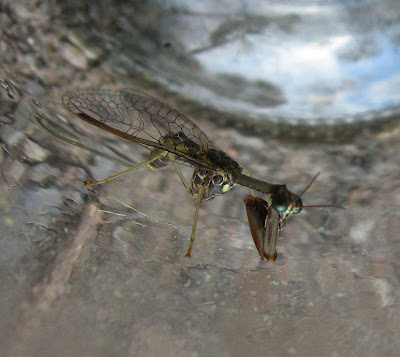It's been a good summer for finding insects that aren't necessarily uncommon but one doesn't encounter very often, such as this offbeat fly with its long antennae, pointy proboscis and hunched back. Photographed at the Menzel Centennial Nature Reserve northwest of Napanee, as its appearance suggests it is indeed a Beefly, family Bombyliidae, genus Lepidophora. And according to this key by the Canadian Journal of Arthropod Identification there is only one member of this genus in Ontario – Lepidophora lutea.
More commonly known as a Scaly Bee Fly or Hunchback Beefly, the adults eat nectar but the larvae are kleptoparasites of Vespid and Sphecid wasps, eating the contents of the cells.
Mantidfly adults are predacious but before attaining adulthood they undergo hypermetamorphosis, a process explained in detail in a fascinating article appropriately titled "Mantidflies: Chimeras of the Insect World" at Life, et al. And according to the fossil record Mantidflies were already masters of their bizarre lifestyle at least 44 million years ago ... Spider-boarding Insect preserved in Amber.











